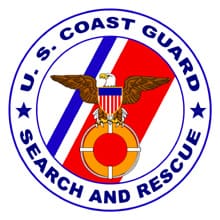Coast Guard officials are continuing the investigation of two suspected hoax distress calls, one in New Jersey and one in Texas, after releasing more information about the case to the public. Officials suspect the calls may be linked.
On June 11, 2012, Coast Guard Vessel Traffic Service New York received a distress call from an unknown individual reportedly aboard the yacht Blind Date claiming that there had been an explosion on their vessel endangering the 21 passengers aboard. The yacht was allegedly 17 miles east of Sandy Hook, N.J. when the explosion took place.
A multi-agency response team including units from New York City Police Department, Fire Department of New York City, New Jersey State Police, and Nassau County Police Department as well as two boats and four Coast Guard helicopter crews was organized to locate and aide the vessel. The 5 1/2-hour, 638-square nautical mile search that ensued failed to produce any evidence of the yacht Blind Date.
Coast Guard Investigative Service New York suspects a link between this unresolved distress call and another in the Houston, Texas area, received on May 20, 2012.
The similarities between the two cases are cited on the Coast Guard's press release:
1. Both calls seem to originate from land. With the Sandy Hook case, Coast Guard direction finding equipment points to an area from the north shore of Staten Island, over New Jersey to near the George Washington Bridge.
2. The caller specifically contacted a Coast Guard Vessel Traffic Service in both cases. Typically when a person is in distress they will ask for the Coast Guard in general or hail mayday on VHF channel 16, the known emergency frequency.
3. The same terminology was used in both the Houston and Sandy Hook case, and not all of it was standard nautical/non-military mariner terminology. The caller, for both cases specifically stated they were “taking on water,” not sinking. He used “souls” to describe the people aboard and “beacon” to describe a supposed automatic signaling device on liferafts.
4. The caller in both cases gave very specific locations of distress and distances, while at the same time exhibiting throughout the calls unfamiliarity with the area and/or using references to location that a boat captain typically wouldn’t use.
5. Voice and manner of speaking were similar for both calls.
The Eighth Coast Guard District which handles operations throughout the Gulf Coast is in charge of the investigation of the May 20th hoax call in Texas.
Capt. Ed Cubanski, chief of the Eighth Coast Guard District incident management branch in New Orleans explained his suspicions saying,“Within the first 24 hours of the response in Sector Houston Galveston, we became suspicious that this call was a hoax because of a few oddities. One, it was called into vessel traffic service Houston-Galveston over Channel 11, two, the distressed vessel’s master easily switched to channel 16, and three, none of our SAR assets found vessel debris. That being said, we had no tangible evidence as we have had in previous hoax cases in the Eighth Coast Guard District. We continued to search on this case with the typical zest, zeal, and vigor that we search on all SAR cases to try to locate and rescue the six reported missing persons.”
The Coast Guard Investigative Service is offering a $3,000 reward for information leading to the arrest and prosecution of the person making the false distress calls. Anyone with information about this probable hoax should contact CGIS at 212-668-7048 or 646-872-5774.

